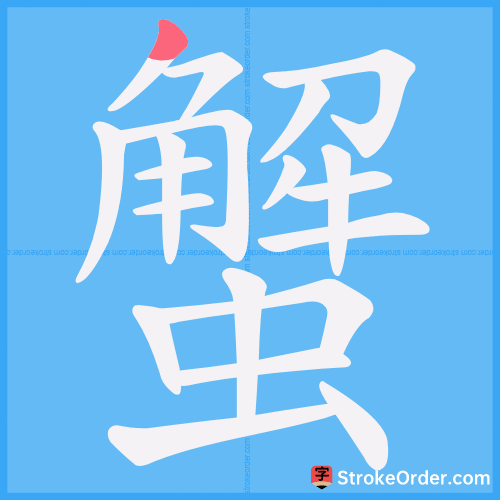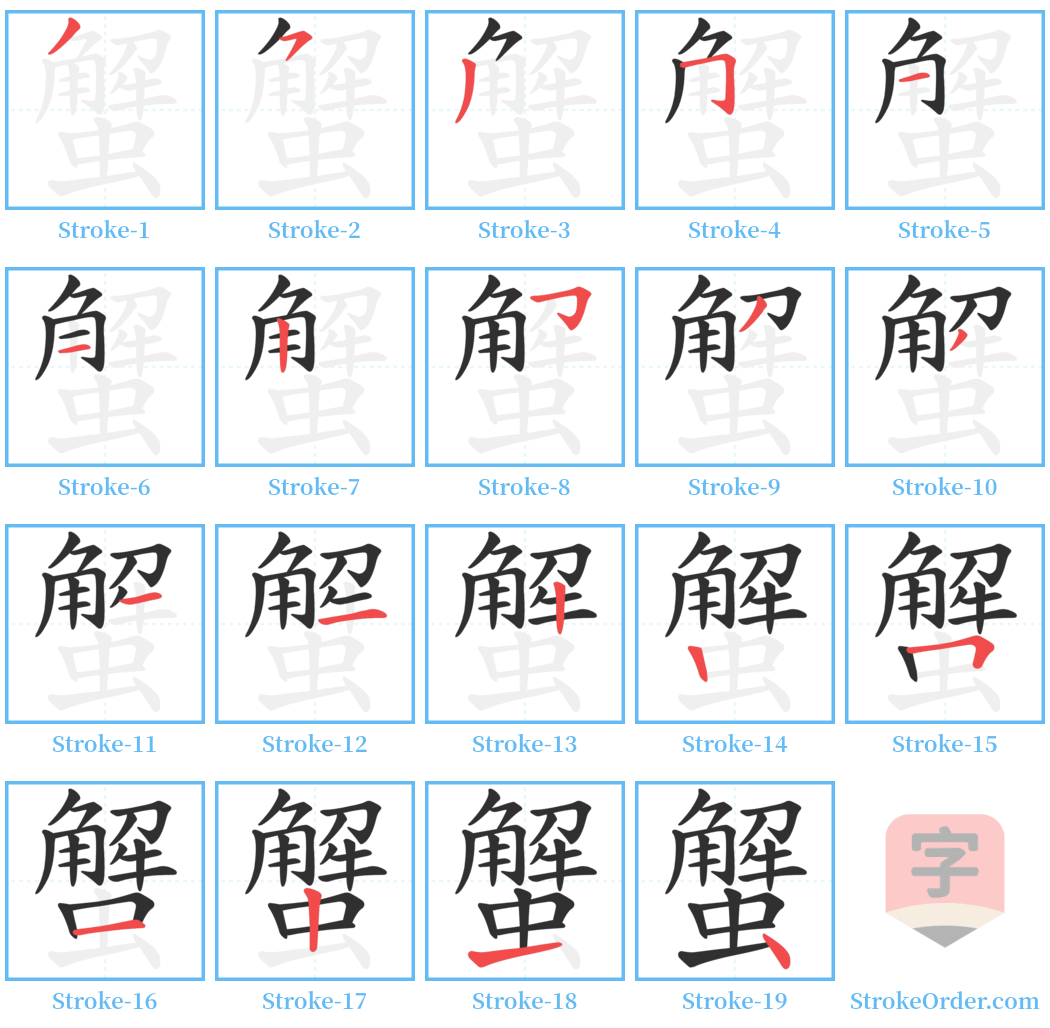蟹 Stroke Order
Animated Stroke Order of 蟹

Stroke Order Diagrams for 蟹

Step-by-Step Handwriting Guide for 蟹

Learn to Write Chinese Characters with Video Tutorials
Watch the video of writing the Chinese character "蟹", learn the correct stroke order (笔顺) of the character "蟹", and master the standard way of writing the character "蟹".
Free Printable Handwriting Practice with Stroke Order: 蟹
Printable Writing Practice Worksheet of "蟹" in Portrait Orientation (Tian Zi Ge)

Printable Writing Practice Worksheet of "蟹" in Landscape Orientation (Tian Zi Ge)

Information of 蟹
Pinyin
xiè
Radical
虫
Strokes
19 strokes
Usage
★★★★★
Definition
crab
蟹
xiè
〈名〉
1. 螃蟹 ([En.] crab)
A crustacean; an aquatic and amphibious arthropod. It has a shell covering its body, five pairs of legs, and the front pair of legs forming pincers called "claws," which move sideways. The abdomen is segmented, commonly referred to as the "belly." The male's belly is long and pointed, while the female's belly is oval-shaped. Commonly referred to as "crab," examples include "river crab," "sea crab," "yellow crab," and "green crab."
2. 动物名。节肢动物,全身有甲壳,前面的一对脚成钳状,横着爬行。
Animal name. A type of crustacean; it has a shell covering its entire body and a pair of pincers at the front, moving sideways.
引
1. 《说文》: 蠏,有二敖、八足、旁行、非蛇鲹之穴无所庇。
"In the Shuowen Jiezi: The crab has two pincers, eight legs, moves sideways, and has no hiding place except for the holes of certain fish."
2. 《易·说卦》: 离为蟹,外刚而内柔也。
"In the I Ching (Explanation of the Trigrams): The 'Li' (fire) is like a crab; firm on the outside but soft on the inside."
3. 《荀子·劝学》: 蟹六跪而二螯。
"In Xunzi (Encouraging Learning): The crab has six legs and two pincers."
4. 《聊斋志异·促织》: 蟹白栗黄。
"In 'Strange Stories from a Chinese Studio': The crab is a whitish-chestnut yellow."
例
又如: 蟹眼(喻指水初沸时冒起的小水泡); 蟹爪(指一种形如蟹爪的画笔); 蟹火(渔人夜晚用来捕蟹的火); 蟹厄(蟹行田中,为害禾稼)
(Also: crab eye (metaphor for small bubbles when water first starts to boil); crab claw (refers to a type of brush shaped like a crab's claw); crab fire (fire used by fishermen at night to catch crabs); crab disaster (when crabs infest the fields and harm the crops))
(*引自繁体辞典解释)
(From the Traditional Chinese Dictionary Explanation)
(一)之又音。
(1) It is also pronounced as.)
river crab / Internet censorship (pun on "harmonious" 和諧|和谐[he2 xie2], which is blocked by the great firewall of China)
shrimp soldiers and crab generals (in mythology or popular fiction, the army of the Dragon King of the Eastern Sea) / useless troops (idiom)
Input Method for 蟹
Pinyin
xie4
Wubi
qevj
Cangjie
nqlmi
Zhengma
rlmi
Four Corner
27136
Unicode
U+87f9
Same Pronunciation Characters